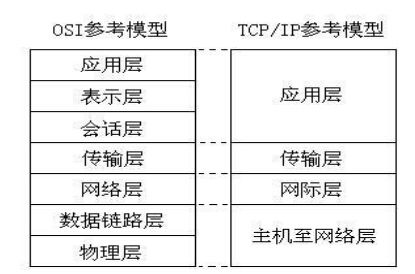Java基础--网络编程01
网络编程
IP地址InetAddress
- 网络中设备的标识;
- 不易记忆,可用主机名;
- 本地回环地址:127.0.0.1;主机名:localhost;
- 端口号:
- 用于标识进程的逻辑地址,不同进程的标识;
- 有效端口:0~65535,其中0~1024系统使用或保留端口;
- 传输协议:
通讯规则,常见协议:TCP,UDP;
InetAddress
- 已知子类:Inet4Address,Inet6Address;此类表示互联网协议(IP)地址;
- 该类没有构造函数,不可通过new创建对象,只能使用方法返回一个InetAddress对象;
- 常用方法:
- getByAddress(String host,byte[] addr)根据提供的主机名IP地址创建InetAddress;host-指定主机,addr-网络字节顺序的原始IP地址;
- getByName(String host);根据给定主机名返回IP地址;host-指定主机(可以是IP,可以是网址);
- getHostAddress();返回IP地址字符串;
- getHostName();获取此IP地址的主机名;
- getLocalHost();返回本地主机;
- toString();将此IP地址转换为String;
- hashCode();返回此IP地址的哈希值;
- getAllByName(String host);根据给定主机名,返回其IP地址所组成的数组;
import java.net.*;
class IPDemo{
public static void main(String[] args) throws Exception{
//InetAddress i = InetAddress.getLocalHost();
// System.out.println(i.toString());
// System.out.println("address:"+i.getHostAddress());
// System.out.println("name:"+i.getHostName());
InetAddress ia = InetAddress.getByName("thinkpad-sl400");
System.out.println("address:"+ia.getHostAddress());
System.out.println("name:"+ia.getHostName());
}
}
TCP和UDP
UDP
- 将数据及源和目的封装在数据包中,不需要建立连接;
- 每个数据包的大小限定在64k内;
- 因为无连接,是不可靠协议;
- 不需要建立连接,速度快;
TCP
- 建立连接,形成传输数据的通道;
- 在连接中进行大数据传输;
- 通过三次握手完成连接,是可靠协议;
- 必须建立连接,效率会稍低;
Socket
- Socket就是为网络服务提供的一种机制;
- 通信的两端都有Socket;
- 网络通信其实就是Socket间的通信;
- 数据在两个Socket间通过IO传输;
UDP传输
- 每个传输协议都有自己不同的建立端点的方式;
- UDP的Socket服务特有传输方式对应的对象:
- 建立UDP Socket服务:
DatagramSocket与DatagramPacket
- 建立发送端,接收端。
- 建立数据包。
- 调用Socket的发送接收方法。
- 关闭Socket。
发送端与接收端是两个独立的运行程序。
DatagramSocket
- 此类表示用来发送和接收数据报包的套接字;
构造方法:
- DatagramSocket();构造函数数据报套接字将其绑定到本机上的任何可用端口;
- DatagramSocket(int port);将其绑定到本地主机上的指定端口;
- DatagramSocket(int port,InetAddress laddr);指定的本地地址;port-要使用的本地端口,laddr-要绑定的本地地址;
- DatagramSocket(SocketAddress bindaddr)~指定的本地套接字地址;
常用方法:
- close();关闭资源;
- receive(DatagramPacket p)从套接字接收数据包;
- send(DatagramPacket p)从套接字发送数据包;
DatagramPacket
- 此类表示数据报包,数据用来实现无连接包投递服务;
构造方法:
- DatagramPacket(byte[] b,int length,InetAddress address, int port);构造函数报包,用来将长度为length的包发送到指定主机上的指定端口号;(用于发送)
- DatagramPacket(byte[] buf,int offset,int length,InetAddress address ,int port );用来将长度为length偏移量的为offset的包发送到指定主机上的指定端口号;(用于发送)
- DatagramPacket(byte[] buf,int length);用来接收长度为length的数据包;(接收)
- DatagramPacket(byte[] buf,int offset,int length);用于接收
常用方法:
- getAddress();返回某台机器的IP,要发往该机器或从该机器接收到的;
- getData();返回数据缓冲区,(接收到的数据)
- getLength();返回要发送或接收到的数据长度;
- getPort();返回某台远程主机的端口号,此数据将要发往该主机或从该主机接收到的;
import java.net.*;
/*
需求:通过udp传输方式,将一段文字数据发送出去。,
定义一个udp发送端。
思路:
1,建立updsocket服务。
2,提供数据,并将数据封装到数据包中。
3,通过socket服务的发送功能,将数据包发出去。
4,关闭资源。
*/
class UdpSend{
public static void main(String[] args) throws Exception{
//1,创建udp服务。通过DatagramSocket对象。
DatagramSocket ds = new DatagramSocket(8888);
//2,确定数据,并封装成数据包。DatagramPacket(byte[] buf, int length, InetAddress address, int port)
byte[] buf = "udp ge men lai le ".getBytes();
DatagramPacket dp =
new DatagramPacket(buf,buf.length,InetAddress.getByName("192.168.1.254"),10000);
//3,通过socket服务,将已有的数据包发送出去。通过send方法。
ds.send(dp);
//4,关闭资源。
ds.close();
}
}
/*
需求:
定义一个应用程序,用于接收udp协议传输的数据并处理的。
定义udp的接收端。
思路:
1,定义udpsocket服务。通常会监听一个端口。其实就是给这个接收网络应用程序定义数字标识。
方便于明确哪些数据过来该应用程序可以处理。
2,定义一个数据包,因为要存储接收到的字节数据。
因为数据包对象中有更多功能可以提取字节数据中的不同数据信息。
3,通过socket服务的receive方法将收到的数据存入已定义好的数据包中。
4,通过数据包对象的特有功能。将这些不同的数据取出。打印在控制台上。
5,关闭资源。
*/
class UdpRece{
public static void main(String[] args) throws Exception{
//1,创建udp socket,建立端点。
DatagramSocket ds = new DatagramSocket(10000);
while(true){
//2,定义数据包。用于存储数据。
byte[] buf = new byte[1024];
DatagramPacket dp = new DatagramPacket(buf,buf.length);
//3,通过服务的receive方法将收到数据存入数据包中。
ds.receive(dp);//阻塞式方法。
//4,通过数据包的方法获取其中的数据。
String ip = dp.getAddress().getHostAddress();
String data = new String(dp.getData(),0,dp.getLength());
int port = dp.getPort();
System.out.println(ip+"::"+data+"::"+port);
}
//5,关闭资源
//ds.close();
}
}
UDP数据的发送与接收
定义一个发送端:
- 创建UDP服务,通过DatagramSocket对象;
- 确定数据,并封装成数据包;
DatagramPacket(byte[] buf,int length,InetAddress address,int port);将数据源转换成byte[]传入UDP; - 通过Socket服务,将已有的数据包发送出去,通过send方法;
- 关闭资源;
定义一个UDP接收端;
- 创建UDP Socket服务,建立端点,通常会监听一个端口;
- 定义数据包,用于存储数据,数据包对象中有更多功能可以提取字节数据中的不同数据信息;
- 通过Socket服务的receive方法将接收到的数据存入定义好的数据包中;
- 通过数据包对象的特有功能,将这些不同的数据取出;
- 关闭资源;
import java.io.*;
import java.net.*;
class TextClient{
public static void main(String[] args) throws Exception{
Socket s = new Socket("192.168.1.254",10006);
BufferedReader bufr =
new BufferedReader(new FileReader("IPDemo.java"));
PrintWriter out = new PrintWriter(s.getOutputStream(),true);
String line = null;
while((line=bufr.readLine())!=null){
out.println(line);
}
s.shutdownOutput();//关闭客户端的输出流。相当于给流中加入一个结束标记-1.
BufferedReader bufIn = new BufferedReader(new InputStreamReader(s.getInputStream()));
String str = bufIn.readLine();
System.out.println(str);
bufr.close();
s.close();
}
}
class TextServer{
public static void main(String[] args) throws Exception{
ServerSocket ss = new ServerSocket(10006);
Socket s = ss.accept();
String ip = s.getInetAddress().getHostAddress();
System.out.println(ip+"....connected");
BufferedReader bufIn = new BufferedReader(new InputStreamReader(s.getInputStream()));
PrintWriter out = new PrintWriter(new FileWriter("server.txt"),true);
String line = null;
while((line=bufIn.readLine())!=null){
//if("over".equals(line))
//break;
out.println(line);
}
PrintWriter pw = new PrintWriter(s.getOutputStream(),true);
pw.println("上传成功");
out.close();
s.close();
ss.close();
}
}
TCP传输
- Socket和ServerSocket
- 建立客户端和服务器端;
- 建立连接后,通过Socket中的IO流进行数据的传输;
- 关闭Socket;
- 同样,客户端与服务器端是两个独立的应用程序;
Socket
- 此类实现客户端套接字,套接字是两台机器间通信的端点;
常用构造函数:
- Socket();空参数时用connect方法连接;
- Socket(InetAddress address,int port);
- Socket(String host,int port);
- Socket(InetAddress address ,int port ,InetAddress localAddr,int localPort);
常用方法:
- getInetAddress();返回此套接字连接的地址;
- getInputStream();返回此套接字的输入法;
- getLocalAddress();获取套接字绑定的本地地址;
- getLocalPort();
- getOutputStream();返回此套接字的输出流;
- getPort();返回此套接字连接到的远程端口;
- shutdownInput();
- shutdownOutput();关闭客户端的输出流,相当于给流中加入一个结束标记(一般用于上传文件接收后,给服务端的readLine发送一个结束标记,以示文件传送玩读取结束);
- connect(SocketAddress endpoint)将套接字连接到服务器用于空参数的套接字连接;(注:SocketAddress 的子类InetSocketAddress封装了IP地址和端口)
ServerSocket
- 此类实现服务器套接字,服务器套接字等待请求通过网络传入;
构造方法:
- serverSocket();
- serverSocket(int port);创建绑定到特定端口的服务器套接字;
- ServerSocket(int port,int backlog);
- serverSocket(int port,int backlog,InetAddress binAddr);backlog:队列的最大长度,即:能连接到服务器的客户端最大的同时在线个数;
常用方法:
- close();关闭资源;
- accept();侦听并接受此套接字的连接;
- getInetAddress();返回此服务器套接字的本地地址;
import java.io.*;
import java.net.*;
/*
演示tcp的传输的客户端和服务端的互访。
需求:客户端给服务端发送数据,服务端收到后,给客户端反馈信息。
*/
/*
客户端:
1,建立socket服务。指定要连接主机和端口。
2,获取socket流中的输出流。将数据写到该流中。通过网络发送给服务端。
3,获取socket流中的输入流,将服务端反馈的数据获取到,并打印。
4,关闭客户端资源。
*/
class TcpClient2 {
public static void main(String[] args)throws Exception {
Socket s = new Socket("192.168.1.254",10004);
OutputStream out = s.getOutputStream();
out.write("服务端,你好".getBytes());
InputStream in = s.getInputStream();
byte[] buf = new byte[1024];
int len = in.read(buf);
System.out.println(new String(buf,0,len));
s.close();
}
}
class TcpServer2{
public static void main(String[] args) throws Exception{
ServerSocket ss = new ServerSocket(10004);
Socket s = ss.accept();
String ip = s.getInetAddress().getHostAddress();
System.out.println(ip+"....connected");
InputStream in = s.getInputStream();
byte[] buf = new byte[1024];
int len = in.read(buf);
System.out.println(new String(buf,0,len));
OutputStream out = s.getOutputStream();
Thread.sleep(10000);
out.write("哥们收到,你也好".getBytes());
s.close();
ss.close();
}
}
/*
需求:建立一个文本转换服务器。
客户端给服务端发送文本,服务单会将文本转成大写在返回给客户端。
而且客户度可以不断的进行文本转换。当客户端输入over时,转换结束。
分析:
客户端:
既然是操作设备上的数据,那么就可以使用io技术,并按照io的操作规律来思考。
源:键盘录入。
目的:网络设备,网络输出流。
而且操作的是文本数据。可以选择字符流。
步骤
1,建立服务。
2,获取键盘录入。
3,将数据发给服务端。
4,后去服务端返回的大写数据。
5,结束,关资源。
都是文本数据,可以使用字符流进行操作,同时提高效率,加入缓冲。
*/
import java.io.*;
import java.net.*;
class TransClient{
public static void main(String[] args) throws Exception{
Socket s = new Socket("192.168.1.254",10005);
//定义读取键盘数据的流对象。
BufferedReader bufr =
new BufferedReader(new InputStreamReader(System.in));
//定义目的,将数据写入到socket输出流。发给服务端。
//BufferedWriter bufOut =
//new BufferedWriter(new OutputStreamWriter(s.getOutputStream()));
PrintWriter out = new PrintWriter(s.getOutputStream(),true);
//定义一个socket读取流,读取服务端返回的大写信息。
BufferedReader bufIn =
new BufferedReader(new InputStreamReader(s.getInputStream()));
String line = null;
while((line=bufr.readLine())!=null){
if("over".equals(line))
break;
out.println(line);
// bufOut.write(line);
// bufOut.newLine();
// bufOut.flush();
String str =bufIn.readLine();
System.out.println("server:"+str);
}
bufr.close();
s.close();
}
}
/*
服务端:
源:socket读取流。
目的:socket输出流。
都是文本,装饰。
*/
class TransServer{
public static void main(String[] args) throws Exception{
ServerSocket ss = new ServerSocket(10005);
Socket s = ss.accept();
String ip = s.getInetAddress().getHostAddress();
System.out.println(ip+"....connected");
//读取socket读取流中的数据。
BufferedReader bufIn =
new BufferedReader(new InputStreamReader(s.getInputStream()));
//目的。socket输出流。将大写数据写入到socket输出流,并发送给客户端。
//BufferedWriter bufOut =
//new BufferedWriter(new OutputStreamWriter(s.getOutputStream()));
PrintWriter out = new PrintWriter(s.getOutputStream(),true);
String line = null;
while((line=bufIn.readLine())!=null){
System.out.println(line);
out.println(line.toUpperCase());
// bufOut.write(line.toUpperCase());
// bufOut.newLine();
// bufOut.flush();
}
s.close();
ss.close();
}
}/*
编写一个聊天程序。
有收数据的部分,和发数据的部分。
这两部分需要同时执行。
那就需要用到多线程技术。
一个线程控制收,一个线程控制发。
因为收和发动作是不一致的,所以要定义两个run方法。
而且这两个方法要封装到不同的类中。
*/
import java.io.*;
import java.net.*;
class Send implements Runnable{
private DatagramSocket ds;
public Send(DatagramSocket ds){
this.ds = ds;
}
public void run(){
try{
BufferedReader bufr = new BufferedReader(new InputStreamReader(System.in));
String line = null;
while((line=bufr.readLine())!=null){
byte[] buf = line.getBytes();
DatagramPacket dp =
new DatagramPacket(buf,buf.length,InetAddress.getByName("192.168.1.255"),10002);
ds.send(dp);
if("886".equals(line))
break;
}
}catch (Exception e){
throw new RuntimeException("发送端失败");
}
}
}
class Rece implements Runnable{
private DatagramSocket ds;
public Rece(DatagramSocket ds){
this.ds = ds;
}
public void run(){
try{
while(true){
byte[] buf = new byte[1024];
DatagramPacket dp = new DatagramPacket(buf,buf.length);
ds.receive(dp);
String ip = dp.getAddress().getHostAddress();
String data = new String(dp.getData(),0,dp.getLength());
if("886".equals(data)){
System.out.println(ip+"....离开聊天室");
break;
}
System.out.println(ip+":"+data);
}
}catch (Exception e){
throw new RuntimeException("接收端失败");
}
}
}
class ChatDemo{
public static void main(String[] args) throws Exception{
DatagramSocket sendSocket = new DatagramSocket();
DatagramSocket receSocket = new DatagramSocket(10002);
new Thread(new Send(sendSocket)).start();
new Thread(new Rece(receSocket)).start();
}
}
